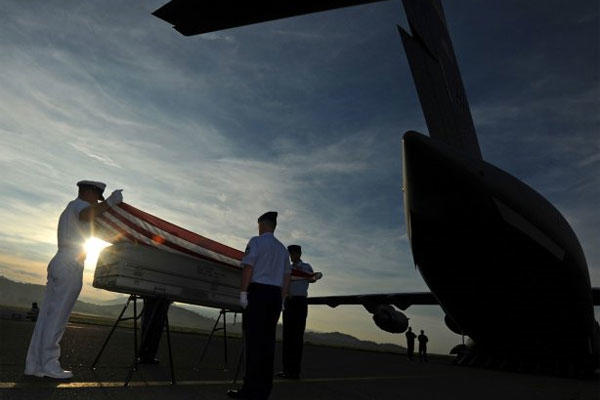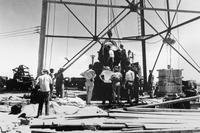NATICK, Mass.-- He will tell you that he's not particularly noteworthy, but Jason Kaye certainly recognizes the importance of his organization's mission.
Kaye serves as a Navy civilian with the Joint Prisoner of War, Missing in Action Accounting Command, or JPAC, at Joint Base Pearl Harbor-Hickam, Hawaii. JPAC seeks to account for every American servicemember missing in this nation's conflicts since World War II. It's hard to imagine a higher calling for a former Infantry Soldier who spent time as a long-range surveillance detachment scout observer with the 1st Cavalry Division.
Since 1988, the year he joined the Army, Kaye has had an MIA bracelet bearing the name of a Soldier who is still missing. Kaye left the Army in 1996, but he kept the bracelet.
"To me, as a veteran," said Kaye, "it's very rewarding to be able to find these personnel."
JPAC faces a herculean task. Nearly 90,000 Americans are unaccounted for, and some six MIAs are identified each month by the command. On average, the organization's 500 Soldiers, Sailors, Airmen, Marines and Navy civilians have 1,000 active cases on their hands.
The JPAC motto reflects the perseverance of staff members such as Kaye: "Until they are home."
Kaye joined JPAC in 2009, as one of the first three civilian photographers the command had ever hired for its investigation and recovery teams. Prior to that, he had been an Army civilian employee at what was then Fort Lewis, Wash., now Joint Base Lewis-McChord.
"They wanted to bring us on board for the sake of continuity," said Kaye, "because most of the military personnel are here for about three years and then they rotate out. So when they rotate out, that institutional knowledge leaves with them."
Kaye has become part of that institutional knowledge. When he's not photographing sites or what the teams find on 35- to 45-day missions, he spends a great deal of time digging and screening dirt to help unearth the remains of the fallen. It is painstaking labor in remote locations, often under extreme weather conditions.
He has survived two earthquakes on one mission, a falling tree that nearly destroyed a team kitchen, 45 days without a shower, and agonizing blisters that wouldn't go away in Vietnam despite expert treatment from the team medic.
"They never really healed," Kaye said. "My feet looked like hamburger by the end of the mission. That was a little rough."
As the 43-year-old Ravenna, Ohio, native pointed out, recovery teams generally work 10 straight days, have a day off, and then repeat that schedule throughout the mission.
"I'm usually the oldest guy on these (missions)," Kaye said. "It's really cool to be able to work with the younger generation of Soldiers."
One of them is Sgt. 1st Class Gary Epley, a team sergeant with whom Kaye worked in Papua New Guinea, Germany and Belgium.
"When I got to JPAC, one of my peers had said to me, 'There are only two great things you can do with your life: one is fight for your country, and the other is bring someone home who did,'" Epley said. "The civilians who work at JPAC are a key part of our overall mission success. Without people like Jason, who possess a unique skill set, the work we do would be much harder.
"It is my opinion that the Soldiers, Sailors, Airmen and Marines have great respect for what the civilian workforce brings to the table and feel that respect reciprocated," Epley said. "We all believe deeply in this mission, and the love of our country is not exclusive to just us in uniform."
So far, Kaye has traveled to Vietnam, Laos, Papua New Guinea, Germany and Belgium. He has been a member of teams that have repatriated remains to JPAC's Central Identification Facility, the world's largest forensic anthropology laboratory, to ease the minds of family members who have waited decades for word of their service members' fates.
"It's obviously the closure that it brings to families," Kaye said. "We tend to use that word quite a bit around here.
"It's always interesting to read the news stories about the families' reaction to having people back. This person has always been on their mind, and you realize that all the work that went into that identification has helped close a chapter and provided some answers."
Kaye typically deploys with recovery teams of about a dozen personnel, including a team leader, a forensic anthropologist and, usually, a team sergeant, linguist, medic, life support investigator, communications specialist, and explosive ordnance disposal technician, among others. They often start as strangers and become fast friends.
"By the end, you're this really tight-knit little group," Kaye said. "Each individual mission has had its own little stories and experiences. At the end, it's like, 'Wow, that was pretty amazing, what we just did.'"
His deployments to Europe on teams searching for aircrews have resonated with Kaye, whose late grandfather, George Kaye, was a waist gunner aboard a B-24 Liberator bomber during World War II.
"The World War II missions that I've done in Europe have been pretty cool," Kaye said. "One of them was a B-24. There were two members of a crew who had never been accounted for. So that was interesting to be able to work on that sort of a case."
Kaye will return to Europe June 23, as part of investigative and recovery teams. He will be gone a total of 90 days, but he considers such absences from his family in Hawaii small hardships compared to what those in uniform endure on combat deployments.
"Last year, I was gone for 180 days," said Kaye of his four missions in 2012. "I get to come home, and no one's actively out trying to kill me."
The JPAC teams do encounter unexploded ordnance during missions, however.
"We recently found some on a Vietnam mission," said Kaye, who has been to the country six times. "There's never been any sort of accident since I've been here, or that I'm aware of. Everyone's obviously very careful around the stuff."
That part of the world can prove difficult in other ways, according to Kaye.
"What's frustrating about going to Southeast Asia is that because of the acidity of the soil there and other reasons like scavenging and things like that, it's very hard to find remains," Kaye said.
Still, on his second trip to Vietnam, his team found the intact skeleton of a missing Marine.
"Finding a full skeleton is pretty rare in Southeast Asia," Kaye said. "I don't know if it's ever been done before. He still had his jungle boots on and his wool socks.
"His identification was really quick. I think it was like two months after we got back to Hawaii he was identified."
No matter where the rest of his career takes him, Kaye said he knows that nothing will compare to his experiences at JPAC.
"Of everything I've done in my life, I think that this is probably the most rewarding and definitely a great source of pride," Kaye said. "It's an honor to be able to do this work.
"It's pretty amazing what we do as a country -- the extent that we go to bring our personnel home."



























